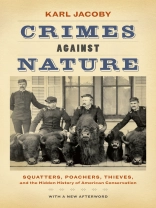Crimes against Nature reveals the hidden history behind three of the nation’s first parklands: the Adirondacks, Yellowstone, and the Grand Canyon. Focusing on conservation’s impact on local inhabitants, Karl Jacoby traces the effect of criminalizing such traditional practices as hunting, fishing, foraging, and timber cutting in the newly created parks. Jacoby reassesses the nature of these ‘crimes’ and provides a rich portrait of rural people and their relationship with the natural world in the late nineteenth and early twentieth centuries.
قائمة المحتويات
Illustrations xi
List of Tables xiii
Preface xv
Introduction: The Hidden History of American Conservation 1
PART I. Forest: The Adirondacks
1. The Re-creation of Nature 11
2. Public Property and Private Parks 29
3. Working-Class Wilderness 48
PART II. Mountain: Yellowstone
4. Nature and Nation 81
5. Fort Yellowstone 99
6. Modes of Poaching and Production 121
PART III. Desert: The Grand Canyon
7. The Havasupai Problem 149
8. Farewell Song 171
Epilogue: Landscapes of Memory and Myth Chronology of American Conservation Notes 203
Bibliography 267
Index 293
Afterword 199
Chronology of American Conservation 205
Notes 209
Bibliography 273
Index 299
عن المؤلف
Karl Jacoby is a professor in the Department of History and in the Center for the Study of Ethnicity and Race at Columbia University. He is the author of Shadows at Dawn: An Apache Massacre and the Violence of History.












